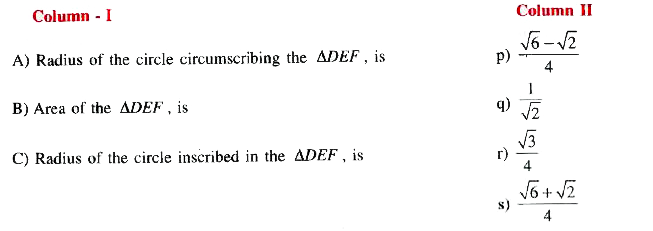If in a triangle ABC sines of angles A and B satisfy the equation 4x2−2√6x+1=0 then cos(A−B)=Solution in Telugu
0
1/2
1/√2
√3/2
The correct Answer is:B
Step by step video, text & image solution for If in a triangle ABC sines of angles A and B satisfy the equation 4x^(2) - 2sqrt6 x + 1 = 0 then cos(A - B) = by Maths experts to help you in doubts & scoring excellent marks in Class 11 exams.
Updated on:21/07/2023Topper's Solved these Questions
- PROPERTIES OF TRIANGLESBOOK - AAKASH SERIESCHAPTER - PROPERTIES OF TRIANGLESEXERCISE - LECTURE SHEET EXERCISE - I (More than One correct answer Type Questions)
4 Videos
- PROPERTIES OF TRIANGLESBOOK - AAKASH SERIESCHAPTER - PROPERTIES OF TRIANGLESEXERCISE - LECTURE SHEET EXERCISE - I (Matrix Matching Type Questions)
1 Video
- PROPERTIES OF TRIANGLESBOOK - AAKASH SERIESCHAPTER - PROPERTIES OF TRIANGLESEXERCISE - PRACTICE EXERCISE
132 Videos
- PLANESBOOK - AAKASH SERIESCHAPTER - PLANESEXERCISE - ADVANCED SUBJECTIVE TYPE QUESTIONS
30 Videos
- PROPERTIES OF VECTORSBOOK - AAKASH SERIESCHAPTER - PROPERTIES OF VECTORSEXERCISE - PRACTICE EXERCISES
55 Videos
Similar Questions
If the sines of the angle A and B of a triangle ABC satisfy the equation c2x2−c(a+b)x+ab=0 . Then the triangle
View SolutionIn a ΔABC,BC=2,CA=1+√3 and ∠C=60∘. Feet of the perpendicular from A, B and on the opposite sides BC, CA and AB are D, E and F respectively and perpendiculars are concurrerant at P.
Now match the entries of Column-I with respective entries of column-II.

View SolutionIf a = 3, b =4 , sin A = 3/4 then ∠B=
View SolutionThe plane 2x + 3y + kz - 7 = 0 is parallel to the line whose d.r's are (2,-3,1) then k=
View SolutionIf ¯¯¯¯¯¯OA=¯i+2¯j−3¯k,¯¯¯¯¯¯OB=3¯i−2¯j+5¯kand2¯¯¯¯¯¯AC=3¯¯¯¯¯¯AB then ¯¯¯¯¯¯AC=
View SolutionIn a triangle ABC ,angle A is greater than angle B.If the measures of angles A and B satisfy the equation 2tan x-k(1+tan^(2)x)=0, where kE(0, 1),then the measure of the angle Cis
View Solutionfin a triangle ABC sines of angles A and B satisfy the equation 4x^(2)-2sqrt(6)x-1=0 then cos(A-B)=
View SolutionIf the tangents of the angles A,B of a Delta ABC... satisfy the equation abx^(2)-c^(2)x+ab=0 then
View SolutionIf the sines of the angle A and B of a triangle ABC satisfy the equation c2x2−c(a+b)x+ab=0, then the triangle
View SolutionIf two sides of a triangle are the roots of the equation 4x2−(2√6)x+1=0 and the included angle is 60∘, then the third side is
View SolutionIf the angles of a triangle ABC satisfy the equation :
81sin2x+81cos2x=30, then the triangle can't be
View SolutionIf in a ΔABC, sines of angles A and B satisfy :
4x2−2√6x+1=0 ,then cos(A−B) equals
View SolutionIf the angles of a triangle ABC satisfy the equation 81sin2x+81cos2x=30, then the triangle can not be
View SolutionIf the sines of the angles A and B of a triangle ABC satisfy the equation c2x2−c(a+b)x+ab=0 , then the triangle (a) is acute angled (b) is right angled (c) is obtuse angled (d) satisfies the equation sinA+cosA (a+b)c
View SolutionIf the sines of the angle A and B of a triangle ABC satisfy the equation c2x2−c(a+b)x+ab=0, then the triangle
View Solution